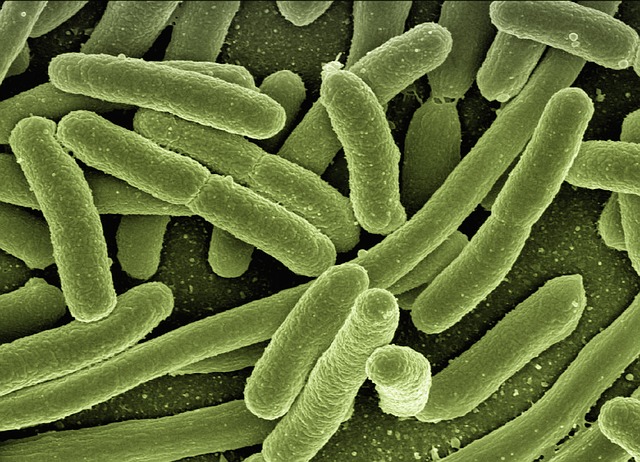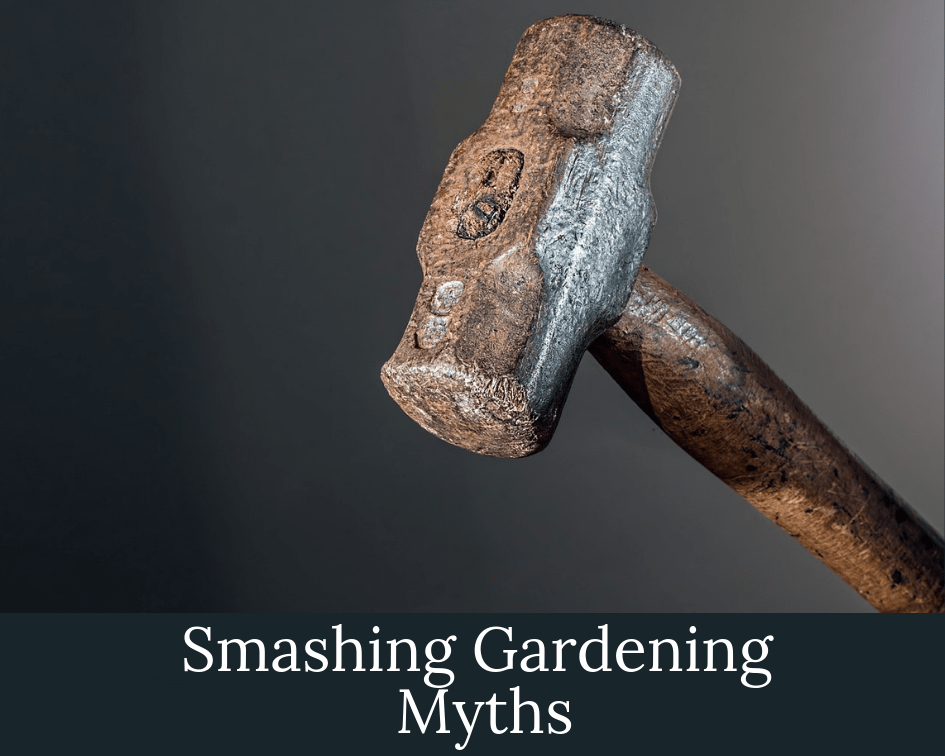This post may contain affiliate links. As an Amazon Associate we earn from qualifying purchases.
I recently found an infographic on Pinterest titled “7 Ways to Improve your Garden Soil Naturally.” The author made some of the time-worn claims perpetuated by gardeners all over the web.
Again, I found myself shaking my head and wondering when this nonsense is going to end. We’re firmly in the 21st century, folks. STOP believing everything you read on the Internet, or, at the very least, take what you read with a grain of salt (or two) if it’s not coming from an expert.
Let’s take a look at some of the gardening advice you may read that you should probably ignore.
1. “Another way to add humidity to the air is by misting your plants”
No, garden writer, that is NOT another way to add humidity to the air.
Yes, this technique might work, but only if you pull up a chair next to the plant and mist it every two to three minutes, all day, all night, every day.
Misting only raises humidity for the amount of time there is water present on the plant. In a dry home, it evaporates quickly.
Banish this silly gardening myth and buy a humidifier. Or, check out other ways to raise humidity for your houseplants, here.

2. The honey-as-a-rooting-hormone gardening myth
Any gardening website that refers to honey as a “rooting hormone” is a site you should quickly back out of. It’s a site with writers who don’t do the heavy lifting for their readers (meaning research).
It’s a site with information that, if followed, could spell disaster for your gardening efforts.
One well-known gardening website, for instance, claims honey is “a natural antiseptic and contains antifungal properties — both of which are believed to be one of the reasons honey as a root hormone seems to work so well.”
Run, don’t walk away from this website. Fungicides and rooting hormones are two entirely different substances that serve two entirely different purposes. Which is why, until recently, some rooting hormone manufacturers included fungicide in their rooting products.
Despite the writer’s later claim that honey contains “possible rooting agents,” it does not. Honey contains no auxins and won’t do a thing to help promote rooting in your cuttings.

3. “Adding a drainage layer allows excess water to get out of the soil more quickly and away from roots before they can be damaged.”
When did water become such an evil and damaging thing for a plant’s roots? And we found this exact quote, on FIFTY-ONE websites, including someone who runs a nursery (who should know better).
You’ll find variations of this advice even from Martha Stewart: “Place a terra-cotta shard over the drainage hole at the bottom of the new pot.”
Thankfully, many gardening writers are wising up to this one, but, as you can see by the quotation marks, some are still advising people to put pebbles or pieces of crockery at the bottom of the pot when repotting container plants.
One of my favorite online horticulturists, Linda Chalker-Scott says that not only is putting “stuff” in the bottom of a planting pot a waste of time, it may actually damage a plant by restricting root growth and impeding drainage.
Do yourself a favor and buy the highest quality potting soil you can find. If your planting pot lacks drainage holes, drill some on the bottom of the pot or buy another pot with drainage holes.
“You have less space and the drainage is not as good, because water sits above the gravel or the stones.”
Interested in learning more? Read her report online at wsu.edu.

4. “Yes, there seem to be good, relevant reasons for using Epsom salts for plants,”
says one prolific gardening myth “writer,” claiming that the product boosts bloom and “enhances a plant’s green color” (and, silly us, we always chalked that up to chlorphyll).
There is not one scientific reference behind any of the claims made by any of the garden writers who claim that Epsom salts are good for plants.
And the reason for that is simple:
“Most of the purported benefits of Epsom salt, especially for home gardens, are not based on scientific evidence,” according to Linda Chalker-Scott, associate professor and extension horticulturist, WSU Puyallup Research and Extension Center.
Epsom salts won’t aid in seed germination, it won’t help plants produce more flowers, it won’t deter pests and its use doesn’t mean that you can reduce the amount of fertilizer required.
And, if you grow tomatoes, be extra careful because “Epsom salt does not prevent blossom end rot; it promotes it,” according to Tom Kalb, extension horticulturist with North Dakota State University.

5. “When sprayed on the leaves, compost tea helps suppress foliar diseases, increases the amount of nutrients available to the plant, and speeds the breakdown of toxins”
What is frightening is that this advice comes from a soil biologist. She even goes on to claim that compost tea can increase “the nutritional quality and improve the flavor of vegetables.”
In reality, studies show that buckets of compost tea “provide a breeding ground for E coli bacteria and disease.” Add that one to the fact that
The EPA lists compost tea as among the “Transmission Pathways for Microbial Hazards.”
Rather makes the “nutritional quality and flavor of the crop” a moot point, doesn’t it? It does in our home.
When one scientist in particular regards compost tea as “scary, scary stuff,” we feel that it’s rather irresponsible to promote its use for the home gardener (former Associate Professor of Horticultural Science and author Jeff Gilman, “The Truth About Organic Gardening: Benefits, Drawbacks, and the Bottom Line”).
For the record, compost tea is a bucket of water to which compost or manure and sugar is added. Often, but not always, the slurry is aerated. After steeping long enough to allow bacteria to grow, it’s sprayed or poured on plants.
Gillman claims that dumping the compost in a bucket of water but leaving out the sugar and not aerating it and allowing the mixture to steep, is most likely perfectly safe and a fine form of fertilizer.
Read Chalker-Scotts research into compost tea as a pesticide, here and as a method of disease control here and here.
And never use fresh manure in the garden, especially when planting seeds of plants you will later eat.

6. “There are many surprising ways to use apple cider vinegar in gardens, and rooting plants with vinegar is one of the most popular.”
Actually, there are two myths in that one sentence: Vinegar is neither a weed killer nor a rooting instigator. Yes, there is a form of vinegar that has shown, scientifically, to enhance rooting and that is wood vinegar.
It’s a byproduct of charcoal production, the liquid that comes from the “gas and combustion of fresh wood burning in an airless” chamber, according to the study “Wood Vinegar and Biochar in Agriculture,” which you can download here.
The final product contains more than 200 compounds and it’s not readily available at your local supermarket or home and garden center.
Yes, we did find it available from a retailer online, but be very careful when shopping for wood vinegar, and here’s why:
- Wood vinegar is very toxic to plants if too much is applied and we’ve yet to find plant-specific instructions as to how much to apply.
- It may retard plant growth if applied at the wrong volume, again, no instructions anywhere as to appropriate volume.
- The carbonization temperature is rather exact and, if it exceeds the ideal, the vinegar contains carcinogens (such as 3.4-benzopyrene and other nasties). We have yet to see a manufacturer mention the carbonization temperature in its marketing materials.
Until wood vinegar becomes a true consumer product, stick with commercial rooting hormone powders, gels or liquids.
Quick review of other myths
Vinegar kills weeds: Maybe the tops but not the roots. And, it takes repeated attempts. And it may kill nearby plants. Weed killer isn’t that expensive.
Coffee grinds increase the soil’s acidity: Temporarily (not long enough to be of benefit). Use sphagnum peat in small beds or aluminum sulfate or elemental sulfur in larger areas.
Use cinnamon as a fungicide: Cinnamon extract and essential oil is beneficial for some seeds at planting. Kitchen cinnamon? No.
Look for essential oils extracted from Cinnamomum zeylanicum (bark and leaf) and Cinnamomum cassia, in the Resources section at the end of this post.
Be aware, however, that this study found that “the germination percentage of seeds treated with the essential oil was significantly lower than the commercial seed treatments.” Consider buying commercial seed treatments.
Honorable mention: Wood ash in the garden
This isn’t exactly a myth to bust, but more of a pet peeve. Yes, wood ash is beneficial to the soil and some plants, in some circumstance.
What most amateur soil scientist writers fail to remind you of is that wood ash has a high pH level and requires careful handling – much like household bleach.
In fact, it should be treated the same way you would treat chemicals you use in your garden:
- Wear gloves, a dust mask and eye protection when working with wood ash.
- Don’t apply wood ash on a windy day.
- Apply wood ash to moist soil and rake it in.
- Never use wood ash “with nitrogen fertilizers such as ammonium sulfate, urea or ammonium nitrate,” cautions Dan Sullivan, soil scientist with the Oregon State University Extension Service.
“These fertilizers lose their nitrogen as ammonia gas when mixed with high pH materials such as wood ash.”
- Ash from burning coal, cardboard, trash or any treated wood (painted, stained, etc.) should never be used in the garden.
- NEVER use wood ash where you’ll plant potatoes, blueberries, rhododendrons and azaleas and don’t apply it to the soil before seeding as it has too many salts and may kill the developing seedling.
Wood ash does work well to get rid of snails and slugs.
If you’d like to know about using wood ash in the garden, the University of Vermont Extension’s Dr. Leonard Perry offers some tips.
If you enjoyed this post, click here to learn about more gardening myths.



